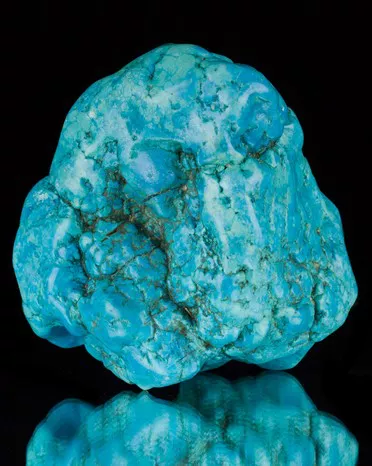Turquoise, with its mesmerizing blue-green hues, has captivated civilizations for thousands of years. This unique gemstone, prized for its vibrant color and historical significance, holds an esteemed place in the world of jewelry and art. But what exactly makes turquoise so valuable? In this article, we delve into the captivating qualities of turquoise, its geological origins, cultural significance, and the factors that contribute to its desirability in the market. Join us as we explore the rich tapestry of turquoise and unravel the secrets behind its enduring value.
1. Geological Origins and Unique Characteristics
Turquoise derives its name from the French word “pierre turquoise,” meaning “Turkish stone,” as it was first introduced to Europe through Turkish trade routes. This opaque gemstone is a hydrous phosphate of copper and aluminum, resulting from the interaction of water with copper-rich rocks over millions of years. It is typically found in arid regions with high copper content, such as Iran, Mexico, and the southwestern United States.
What sets turquoise apart from other gemstones is its captivating color range, varying from sky blue to shades of green. This color variation is attributed to the presence of copper, iron, and other trace elements. Additionally, turquoise often exhibits a unique phenomenon called “matrix,” where intricate spiderweb-like patterns are formed by veins of the host rock.
The delicacy and porosity of turquoise make it susceptible to changes in color and stability over time. This makes high-quality, undamaged turquoise even rarer, further enhancing its desirability and value.
2. Cultural Significance and Historical Importance
Throughout history, turquoise has held immense cultural and symbolic significance for various civilizations. The stone has been cherished by ancient Egyptian pharaohs, Native American tribes, Persians, and Tibetan Buddhists, among others.
In ancient Egypt, turquoise was associated with the goddess Hathor and believed to offer protection and ward off evil spirits. The Persians believed that turquoise reflected the heavens, and it was often incorporated into jewelry and ceremonial objects.
Native American tribes, such as the Navajo and Pueblo, consider turquoise a sacred stone, representing wisdom, protection, and connection to the natural world. It has adorned tribal jewelry and ceremonial objects for centuries.
Turquoise also played a prominent role in Tibetan Buddhism. Known as “sky stone,” it symbolizes purity and spiritual enlightenment. Tibetan Buddhists often use turquoise in religious rituals and as amulets for protection.
The historical importance and cultural significance attached to turquoise add to its allure and value in the market. Collectors and enthusiasts are drawn to the stories and traditions associated with this gemstone, making it highly sought after in the world of fine jewelry and art.
3. Turquoise in the Market: Demand and Factors Influencing Value
In recent years, the demand for turquoise in the global market has experienced significant growth. The surge in popularity can be attributed to several factors.
First and foremost, the limited supply of high-quality turquoise contributes to its value. Due to its fragile nature, natural turquoise without any treatments or enhancements is highly sought after. This scarcity, combined with its unique color and matrix patterns, drives up the price for genuine, premium-quality turquoise.
Secondly, the rise in appreciation for artisanal and handmade jewelry has fueled the demand for turquoise. Designers and consumers are drawn to the earthy, organic qualities of this gemstone, as it complements both contemporary and traditional designs. Turquoise’s versatility allows it to be set in a range of jewelry styles, from intricate silver and gold settings to modern and minimalist designs.
Thirdly, the increasing interest in sustainable and ethically sourced gemstones has led to a rise in the demand for turquoise. Artisanal miners who adhere to responsible mining practices and support local communities are now favored by conscientious consumers. Such practices ensure the preservation of turquoise mines for future generations while supporting the livelihoods of those involved in its extraction.
Furthermore, celebrity endorsements and popular culture references have played a significant role in boosting the desirability of turquoise. Celebrities often wear turquoise jewelry on red carpets and in fashion shoots, further popularizing the gemstone among their fan base. Additionally, films, TV shows, and social media influencers frequently showcase turquoise, creating a heightened interest and market demand.
Conclusion
Turquoise’s allure and value lie in its geological origins, unique characteristics, historical importance, and increasing market demand. Its mesmerizing color variations, cultural significance, and limited supply contribute to its exceptional worth. As the appreciation for sustainable and ethically sourced gemstones continues to grow, turquoise remains a highly sought-after gemstone for jewelry designers, collectors, and individuals seeking a piece of natural beauty steeped in rich history. Whether adorning a piece of exquisite jewelry or serving as a centerpiece in an art collection, turquoise continues to shine as one of the most valuable gemstones on the market.


